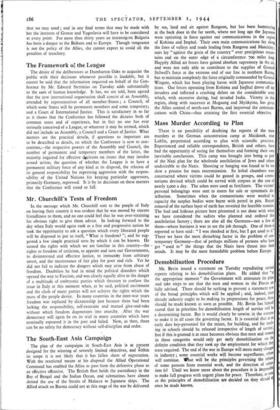The South-East Asia Campaign
The plan of the campaigns in South-East Asia is at pIesent designed for the winning of severely limited objectives, and within its scope it is not likely that it has fallen short of expectation. With the restricted means at his disposal the Allied Operational Command has enabled the Allies to pass from the defensive phase to an effective offensive. The British fleet holds the ascendancy in the Bay of Bengal and the Indian Ocean, and submarines have almost denied the use of the Straits of Malacca to Japanese ships. The Allied attack on Burma could not at this stage of the war be delivered by sea, land and air against Rangoon, but has been hammering at the back door in the far north, where not long ago the Japanese were operating in force against our communications in the region of Kohima and Imphal. Their own main communications lay along the lines of valleys and roads leading from Rangoon and Mandalay; ours lay " against the grain of the country " over precipitous moun- tains and on the outer edge of a circumference 700 miles long. Happily Allied air forces have gained absolute supremacy in the air, and were not only able to contribute to the supplies of General Stilwell's force at the extreme end of our line in northern Burma, but to maintain completely the force originally commanded by General Wingate, which has been playing havoc with Japanese communica- tions. Our forces operating from Kohima and Imphal drove off the invaders and inflicted a crushing defeat on the considerable army which, with excessive daring, had invaded India. Victory in this region, along with successes at Mogaung and Myitkyina, has given the Allies control of north-east Burma, and improved the communi- cations with China—thus attaining the first essential objective.


























 Previous page
Previous page